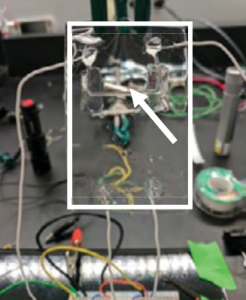
Figure: Soft artificial nerve interface testing
Dr. in het Panhuis’s research in soft robotics draws inspiration from biological systems to 3D print structures that enhance human aquatic mobility and build soft structures that sense human nerves. Soft nerve electrodes and 3D printed bio-structures contribute towards the bionics vision by developing tools necessary to build bio-hardware and bio-electronics that can form the basis of a bionic system.
C. Hamilton, K. Tian, J. Bae, C. Yang, G. Alici, G. M. Spinks, Z. Suo, J. J. Vlassak, and M. in het Panhuis, “A Soft Stretchable Sensor: Towards Peripheral Nerve Signal Sensing,” MRS Advances, vol. 3, no. 28, pp. 1597–1602, 2018 shows that soft electrodes can be 3D printed from ionically conductive gels and could sense signals from peripheral nerves from a distance via capacitive coupling. This allows detection of neural signals at high resolution and without the mechanical property mis-match between nerve and electrode that causes failure of many other electrode types.
